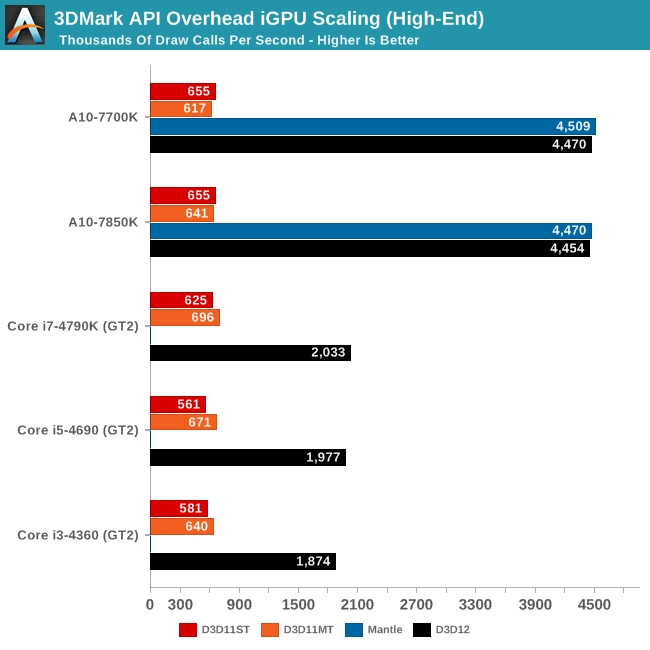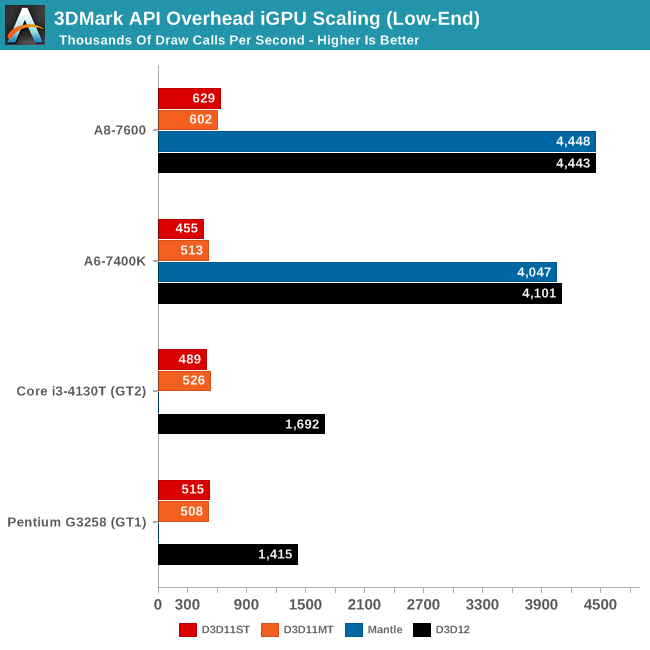Exploring DirectX 12: 3DMark API Overhead Feature Test
by Ryan Smith & Ian Cutress on March 27, 2015 8:00 AM EST- Posted in
- GPUs
- Radeon
- Futuremark
- GeForce
- 3DMark
- DirectX 12
Integrated GPU Testing
Switching gears from high performance discrete GPUs, we have our integrated GPUs. From a high level overview the gains from DirectX 12 are not going to be quite as large here as they are with dGPUs due to the much lower GPU performance, but there is still ample opportunity benefit from increased draw call performance.
Here we have Intel’s Haswell CPUs, and AMD’s Kaveri APUs. We'll start off with the higher-end processors, the Intel Core i3/i5i7 and AMD A10/A8.

As expected, at the high-end the performance gains from DirectX 12 are not quite as great as they were with the dGPUs, but we’re still seeing significant gains. The largest gains of course are found with the AMD processors, thanks to their much stronger iGPUs. From DX11ST to DX12 we’re seeing a surprisingly large 6.8x increase in draw call performance, from 655K to 4,470K.
As to be expected, with a relatively weak CPU, AMD’s DX11 draw call performance isn’t very strong here relative to their strong GPU and of course our more powerful dGPUs. Still, it ends up being better than Intel (who otherwise has the stronger CPU), so we see AMD offering better draw call throughput at all levels. Ultimately what this amounts to is that AMD has quite a bit more potential under DX12.
Mantle meanwhile delivers a very slight edge over DX12 here, although for all practical purposes the two should be considered tied.
Meanwhile for the Intel CPUs, the gains from DX12 aren’t quite as large as with the AMD processors, but they’re still significant, and this is why Intel is happily backing DX12. All 3 processors share the same GT2 GPU and see similar gains. Starting from a baseline of 625K draw calls under DX11 – almost identical to AMD – the i7-4790K jumps up by 3.2x to 2,033K draw calls under DX12. The i5 and the i3 processors see 1,977K and 1,874K respectively, and after adjusting for clockspeeds it’s clear that we’re GPU command processor limited at all times here, hence why even a 2 core i3 can deliver similar gains.
Intel does end up seeing the smallest gains here, but again even in this sort of worst case scenario of a powerful CPU paired with a weak CPU, DX12 still improved draw call performance by over 3.2x. This means that in the long run even games that are targeting lower-performance PCs still stand to see a major increase in the number of draw calls they can use thanks to DirectX 12.

The story is much the same with our lower performance processors. AMD continues to see the largest gains and largest absolute performance under DirectX 12. With a 7x performance increase for the A8, even this weaker processor benefits greatly from the use of a low-level API.
The Intel processors see smaller gains as well, but they too are similarly significant. Even the Pentium with its basic GT1 processor and pair of relatively low clocked CPU sees a 2.7x increase in draw call performance from DirectX 12.










113 Comments
View All Comments
silverblue - Saturday, March 28, 2015 - link
Well, varying results aside, I've heard of scores in the region of eight million. That would theoretically (if other results are anything to go off) put it around the level of a mildly-overclocked i3 (stock about 7.5m). Definitely worth bearing in mind the more-than-six-cores scaling limitation showcased by this test - AMD's own tests show this happening to the 8350, meaning that the Mantle score - which can scale to more cores - should be higher. Incidentally, the DX11 scores seem to be in the low 600,000s with a slight regression in the MT test. I saw these 8350 figures in some comments somewhere but forgot where so I do apologise for not being able to back them up, however the Intel results can be found here:http://www.pcworld.com/article/2900814/tested-dire...
I suppose it's all hearsay until a site actually does a CPU comparison involving both Intel and AMD processors. Draw calls are also just a synthetic; I can't see AMD's gaming performance leaping through the stratosphere overnight, and Intel stands to benefit a lot here as well.
silverblue - Saturday, March 28, 2015 - link
Sorry, stock i3 about 7.1m.oneb1t - Saturday, March 28, 2015 - link
my fx-8320@4.7ghz + R9 290x does 14.4mil :) in mantleLaststop311 - Friday, March 27, 2015 - link
I think AMD APU's are the biggest winner here. Since draw calls help lift cpu bottlenecks and the apu's have 4 weaker cores the lack of dx11 to be able to really utilize multi core for draw calls means the weak single threaded performance of the apus could really hold things back here. DX12 will be able to shift the bottleneck back to the igpu of the apu's for a lot of games and really help make more games playable at 1080p with higher settings or at least same settings and smoother.If only AMD would release an updated version of the 20 cu design for the ps4 using GCN 1.3 cores + 16GB of 2nd generation 3d HBM memory directly on top that the cpu or gpu could use, not only would you have a rly fast 1080p capable gaming chip you could design radically new motherboards that omit ram slots entirely. Could have new mini itx boards that have room for more sata ports and usb headers and fan headers and more room available for vrm's and cool it with good water cooling like the thermaltake 3.0 360mm rad AIO and good TIM like the coollaboratory liquid metal ultra. Or you could even take it the super compact direction and even create a smaller board than mini-itx and turn it into an ultimate htpc. And as well as the reduced size your whole system would benefit from the massive bandwidth (1.2TB/sec) and reduced latency. The memory pool could respond in real time to add more space for the gpu as necessary and since apu's are really only for 1080p that will never be a problem. I know this will probably never happen but if it did i would 100% build my htpc with an apu like that
Laststop311 - Saturday, March 28, 2015 - link
As a side question, Is there some contractual agreement that will not allow AMD to sell these large 20 cu designed APU's on the regular pc market? Does sony have exclusive rights to the chip and the techniques used to make such a large igpu? Or is it die size and cost that scares AMD from making the chip for the PC market as their would be a much higher price compared to current apu's? I'm sure 4 excavator cores cant be much bigger than 8 jaguar so if its doable with 8 jaguar it should be doable with 4 excavator, especially if they put it on the 16/14nm finfet node?silverblue - Saturday, March 28, 2015 - link
I'm sure Sony would only be bothered if AMD couldn't fulfill their orders. A PC built to offer exactly the same as the PS4 would generally cost more anyway.They can't very well go from an eight FPU design to one with two/four depending on how you look at it, even if the clocks are much higher. I think you'd need to wait for the next generation of consoles.
FriendlyUser - Saturday, March 28, 2015 - link
I really hope the developers put this to good use. I am also particularly excited about multicore scaling, since single threaded performance has stagnated (yes, even in the Intel camp).jabber - Saturday, March 28, 2015 - link
I think this shows that AMD has got a big boost from being the main partner with Microsoft on the Xbox. It's meant that AMD got a major seat at the top DX12 table from day one for a change. I hope to see some really interesting results now that it appears finally AMD hardware has been given some optimisation love other than Intel.Tigran - Saturday, March 28, 2015 - link
>>> Finally with 2 cores many of our configurations are CPU limited. The baseline changes a bit – DX11MT ceases to be effective since 1 core must be reserved for the display driver – and the fastest cards have lost quite a bit of performance here. None the less, the AMD cards can still hit 10M+ draw calls per second with just 2 cores, and the GTX 980/680 are close behind at 9.4M draw calls per second. Which is again a minimum 6.7x increase in draw call throughput versus DirectX 11, showing that even on relatively low performance CPUs the draw call gains from DirectX 12 are substantial. <<<Can you please explain how can it be? I thought the main advantage of new APIs is the workload of all CPU cores (instead of one in DX11). If so, should't the performance double in 2-core mode?Why there is 6.7x increase in draw call instead of 2x ?
Tigran - Saturday, March 28, 2015 - link
Just to make it clear: I know there such advantage of Mantle and DX12 as direct addressing GPU, w/o CPU. But this test is about draw calls, requested from CPU to GPU. How can we boost the number of draw calls apart from using additional CPU core?